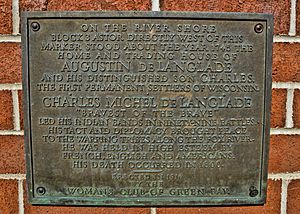Charles Michel de Langlade facts for kids
Quick facts for kids
Charles Michel Mouet de Langlade
|
|
|---|---|
| Born | 9 May 1729 Fort Michilimackinac, Pays d'en Haut, New France |
| Died | Winter 1800–1801 La Baye, Northwest Territory, USA |
| Allegiance | Ojibwa Indian Tribe |
| Service/ |
French Marines British Indian Department |
| Years of service | 1750–1761 1763–1800 |
| Rank | Lieutenant (Marines) 1760 Captain (Indian Department) 1775 |
| Commands held | Commandant of Fort Michilimackinac, 1760–1761 |
| Battles/wars | Raid on Pickawillany Seven Years' War |
Charles Michel Mouet de Langlade (born May 9, 1729 – died after July 26, 1801) was an important leader in the Great Lakes region. He was a fur trader and a war chief. He helped protect French lands in North America.
His mother was from the Odawa people, and his father was a French Canadian fur trader. Charles knew both the Odawa language and French very well. He often led Native American fighters in battles.
Over time, he and his followers worked with different groups. They were allies with the French, then the British, and later the Americans. In 1752, he led French and Native American forces. They destroyed Pickawillany, a Miami village and British trading post. This was in what is now Ohio. France and Britain were fighting for control of the valuable fur trade there.
During the Seven Years' War, Langlade helped defend Fort Duquesne (now Pittsburgh) against the British. The French made him second in command at Fort Michilimackinac. He also became a captain in the French Canadian Indian Department.
After France lost the war in North America, Langlade joined the British. The British took over the old French lands and led the fur trade. During the American Revolutionary War, Langlade led Great Lakes Native Americans for the British. They fought against the American colonists and their Native American allies. The Native Americans hoped to stop the Americans from settling their lands.
After the war, Langlade went back to his home in Green Bay, Wisconsin. He had run a trading post there since 1745 and lived there with his family. He is known as the "Father of Wisconsin."
Early Life and Learning
Charles de Langlade was born in 1729 at Fort Michilimackinac, in New France. His mother, Domitilde, was the daughter of an Ottawa chief. Her brother, Nissowaquet, became an important Ottawa war chief.
Charles's father was Augustin Langlade, a French-Canadian fur trader. He was Domitilde's second husband. They married in 1728. Augustin thought this marriage would help him in the fur trade. It gave him a direct link to the Odawa people.
The Odawa were part of the Algonquian Anishinaabeg groups. These groups lived around the Great Lakes. Charles grew up speaking Ottawa as his first language. He felt a strong connection to his mother's culture. He also learned French from Jesuit missionaries at the fort.
His Life and Actions

In 1745, Augustin Langlade and his 16-year-old son Charles set up a trading post. This was in what is now Green Bay, Wisconsin.
In the winter of 1751–1752, Langlade gathered a group of warriors. They were Odawa, Potawatomi, and Ojibwe fighters. They traveled to Pickawillany to attack it. Their goal was to stop British trading in that area.
On June 21, 1752, they attacked. The Odawa killed an Englishman and the Miami chief Memeskia. This event made tensions worse between the groups. It helped start the French and Indian War. This war was part of the larger Seven Years' War in Europe.
In 1755, Langlade led a group from the Three Fires confederacy. They helped defend Fort Duquesne (now Pittsburgh). The French and their Native American allies won against the British. The British forces were led by Edward Braddock and colonist George Washington. This was at the Battle of the Monongahela.
Langlade also fought in the Siege of Fort William Henry. Later, he led Ottawa warriors at the Battle of the Plains of Abraham. This battle was to defend Quebec.
In 1757, Langlade became the second in command for the French at Fort Michilimackinac. In 1761, Langlade gave up the French fort to the British Army. After the British won the war, Langlade changed his loyalty to them. The British took control of French lands east of the Mississippi River. The next year, he moved his family to the settlement now called Green Bay, Wisconsin.
During the American Revolutionary War, Langlade helped the British. He led Great Lakes Native Americans as their ally. He was promoted to captain in the British Indian Department. When that war ended, Langlade went back to his home in Green Bay. At that time, Green Bay was part of the United States' Northwest Territory. He lived there until he died in the second half of 1801.
Legacy and Honors
- Langlade is remembered as the "Father of Wisconsin."
- Langlade County, Wisconsin is named after him.
- The seal of the Langlade County Historical Society shows an image of Langlade. This image was designed by his relative, the famous sculptor Sidney Bedore.
See also
 In Spanish: Charles Michel de Langlade para niños
In Spanish: Charles Michel de Langlade para niños

